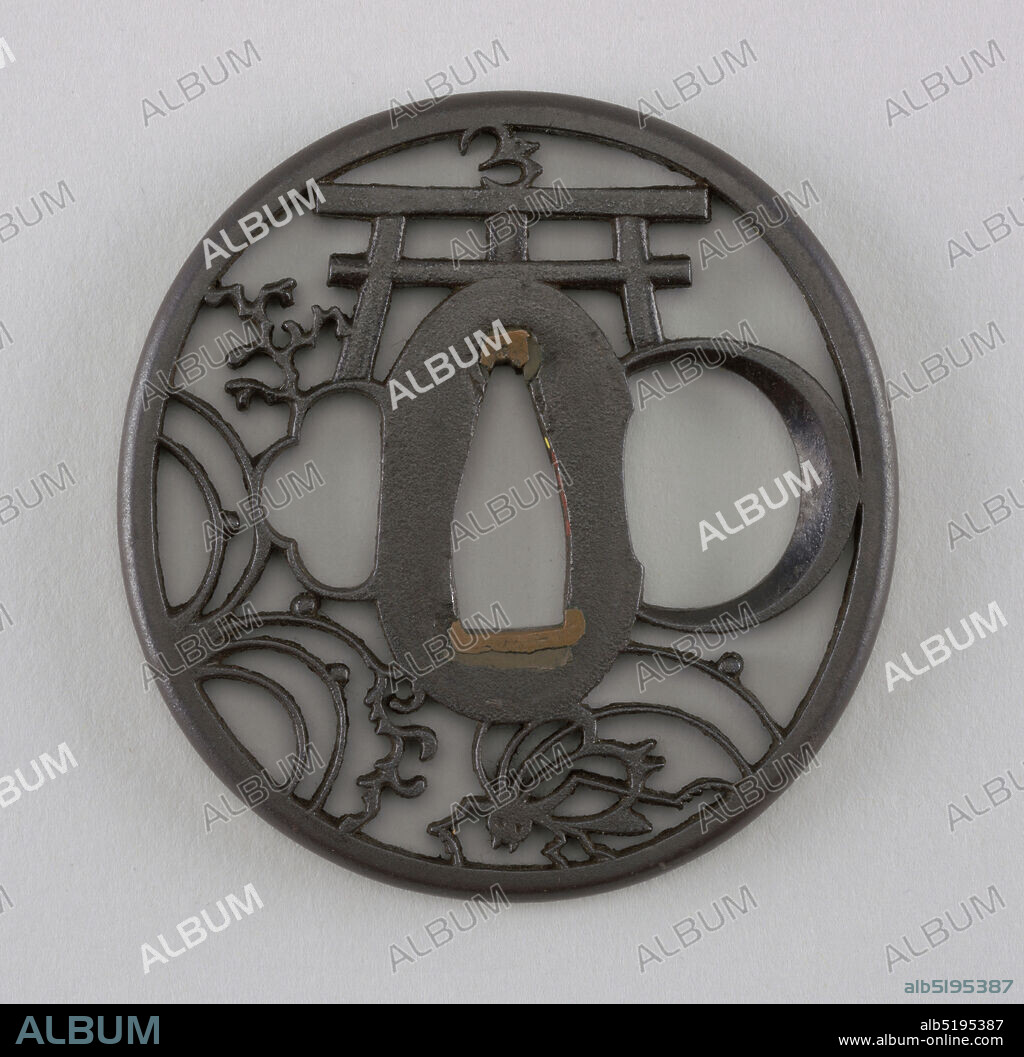alb5195387
Tsuba, Iron, shakudo (a soft copper and gold alloy), Probably Akaska school of Edo. This iron tsuba is naga maru gata (round) in shape, and is crafted in the ji sukashi openwork style, with a positive design showing mika tsuki, korogi, ran and torii (crescent moon, cricket, orchid and shrine gate), possibly making an allusion to a poem. At the center is a wide nakago-ana, an opening through which the sword passes, with sekigane (plugs added to fit the tsuba to a sword) made of shakudo (a soft copper and gold alloy). Surrounding this is the seppadai, a flat oval area that has a migaki ji (smooth) surface finish. On either side are ryo-hitsu, openings for the kozuka (utility knife) and the kogai (skewer tool). At right is sashi ura, the side which faces the blade, whose opening takes the negative form of a moon. Opposite is the sashi omote side, which faces the sword hilt. Its tri-lobed opening is of the suhama type, and symbolically represents the coastline of Horai, the holy island of the Immortals. The rim of the tsuba is round, or maru-mimi., Japan, 19th century, metalwork, Decorative Arts, Tsuba.

|
Add to another lightbox |
|
Add to another lightbox |



Buy this image.
Select the use:

Caption:
Tsuba, Iron, shakudo (a soft copper and gold alloy), Probably Akaska school of Edo. This iron tsuba is naga maru gata (round) in shape, and is crafted in the ji sukashi openwork style, with a positive design showing mika tsuki, korogi, ran and torii (crescent moon, cricket, orchid and shrine gate), possibly making an allusion to a poem. At the center is a wide nakago-ana, an opening through which the sword passes, with sekigane (plugs added to fit the tsuba to a sword) made of shakudo (a soft copper and gold alloy). Surrounding this is the seppadai, a flat oval area that has a migaki ji (smooth) surface finish. On either side are ryo-hitsu, openings for the kozuka (utility knife) and the kogai (skewer tool). At right is sashi ura, the side which faces the blade, whose opening takes the negative form of a moon. Opposite is the sashi omote side, which faces the sword hilt. Its tri-lobed opening is of the suhama type, and symbolically represents the coastline of Horai, the holy island of the Immortals. The rim of the tsuba is round, or maru-mimi., Japan, 19th century, metalwork, Decorative Arts, Tsuba
Credit:
Album / quintlox
Releases:
Image size:
5455 x 5351 px | 83.5 MB
Print size:
46.2 x 45.3 cm | 18.2 x 17.8 in (300 dpi)
Keywords:
19 CENTURY • 19TH CENTURY • 19TH CENTURY. • 19TH • 19TH-CENTURY • AKASKA SCHOOL • ALLUSION • BLADE • CENTER • COAST • COASTAL • COASTLINE • CRAFTED • CRESCENT MOON • CRICKET (SPORT) • CRICKET • CRICKET, GAME • CRIQUET • DECORATIVE ARTS • EDO • FACES • FIT • FLAT OVAL AREA • FLOWER: ORCHID • FORMS (GEOMETRIC) • GOLD ALLOY • HOLY ISLAND • HORAI • IMMORTALS • INSECT: CRICKET • IRON (METAL) • IRON TSUBA • IRON • JAPAN • JAPAN. • JAPANESE • JI SUKASHI OPENWORK STYLE • KOGAI • KOROGI • KOZUKA • LUNA • MARITIME • MARU-MIMI • METALWORK • METALWORKS • MIGAKI JI • MIKA TSUKI • MOON • NAGA MARU GATA • NEGATIVE FORM • NINETEENTH CENTURY • OPENING TAKES • OPENING • OPENINGS • OPPOSITE • ORCHID • PLUGS ADDED • POEM • POSITIVE DESIGN • RAN • RIGHT • RIM • ROUND • RYO-HITSU • SASHI OMOTE SIDE • SASHI URA • SEASHORE • SEASIDE • SEKIGANE • SEPPADAI • SHAKUDO • SHAPE • SHAPES • SHORELINE • SHRINE GATE • SIDE • SKEWER TOOL • SMOOTH • SOFT COPPER • SUHAMA TYPE • SURFACE FINISH • SURROUNDING • SWORD HILT • SWORD PASSES • SWORD • SYMBOLICALLY REPRESENTS • TORII • TRI-LOBED OPENING • TSUBA • UTILITY KNIFE • WIDE NAKAGO-ANA • XIX CENTURY
 Pinterest
Pinterest Twitter
Twitter Facebook
Facebook Copy link
Copy link Email
Email
